Anthurium species grown as houseplants can offer two distinct types of visual appeal, but all benefit from the same watering strategy.
This genus includes around 825 species, and the popular A. andraeanum and A. scherzerianum are prized for their colorful, heart-shaped spathes.
With other types, including A. clarinervium and A. crystallinum, deep green leaves with contrasting light veins are the draw.
Whether you’re captivated by varieties that provide striking foliage or indoor color year-round, one aspect of growing and caring for anthurium is a constant: They appreciate frequent drinks, but may develop root rot or leaf blight in overly wet soil.
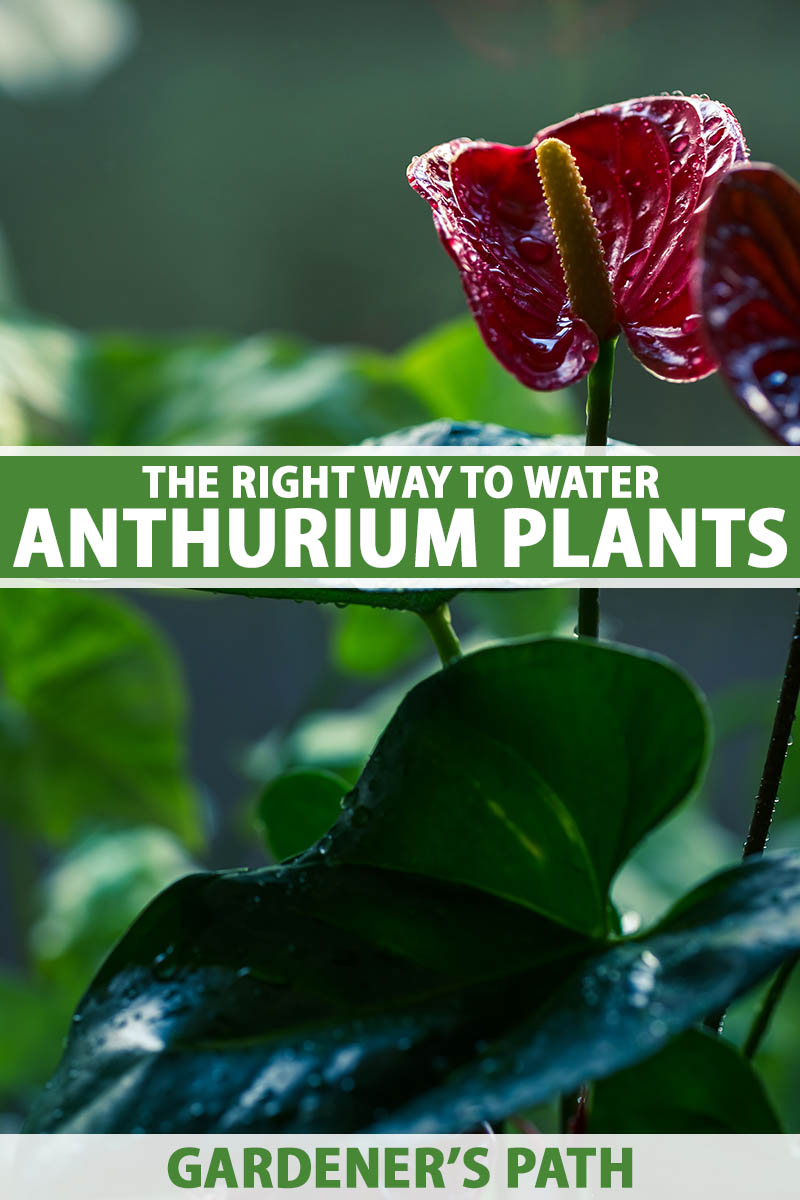
We link to vendors to help you find relevant products. If you buy from one of our links, we may earn a commission.
How much water do these tropical indoor plants require? I’ll delve into that, along with some tips for setting yourself up for success right from the start.
Here’s what I’ll cover:
What You’ll Learn
Soil and Container Considerations
Originating in tropical regions of North and South America, most anthuriums are epiphytes, also known as air plants.
In the wild, their aerial roots allow them to anchor themselves to grow up the surface of taller plants, so they can reach sunlight higher in the canopy.
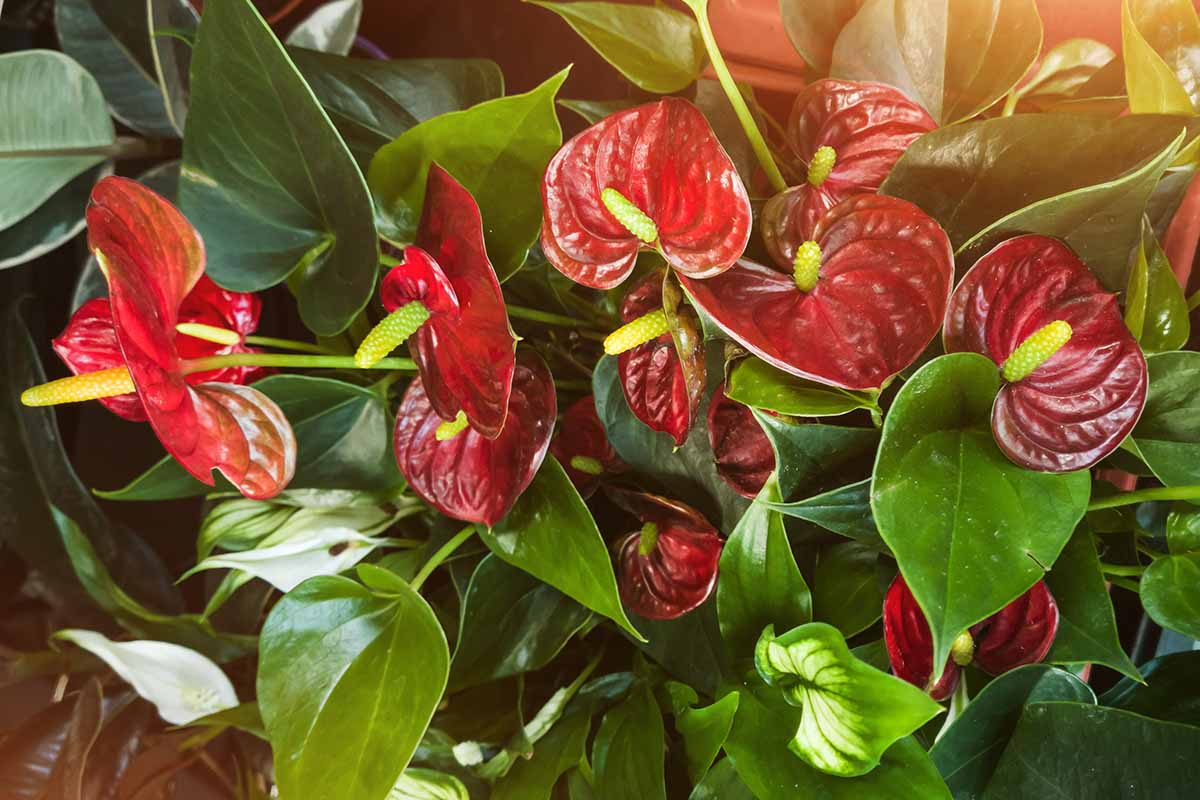
For houseplants, it’s the roots below the soil that take in moisture, so an appropriate container and soil mix will help them along.
Most any type of container will work, as long as it has drainage holes.
You’ll also want to provide a drainage tray or saucer below the pot. This gives you a way to collect and dispose of any excess that drains from the soil, so the roots aren’t subjected to root rot, which can develop if they rest in standing water.
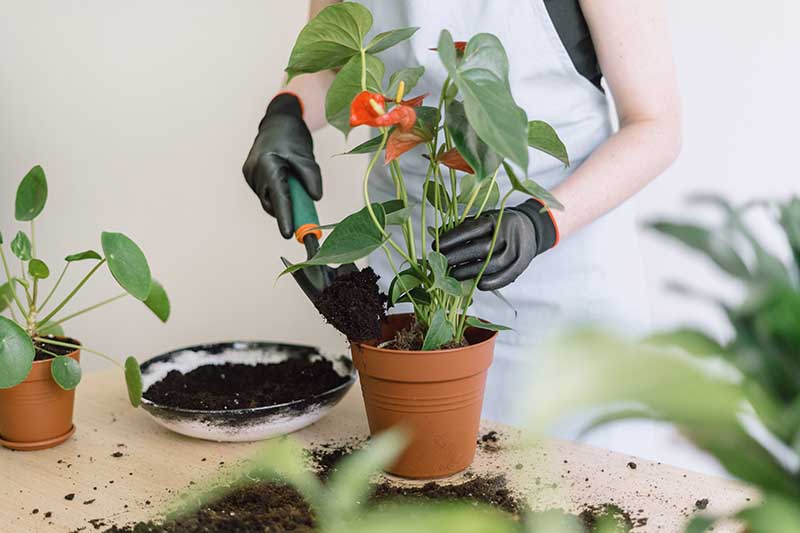
If you want to grow anthurium in an attractive container without drainage holes, consider planting it in a container that has the holes but will fit inside the more decorative planter. Make sure you’ll have room for a drainage saucer inside, too.
It’s important to provide a suitable growing medium as well. As air plants, anthuriums need a coarse, porous mix of perlite and pine bark, coconut coir, or peat moss. Such a growing medium will allow moisture to reach the roots and the excess to drain, discouraging root decay.
For an easy solution, combine cactus mix, which is porous, and orchid mix, which typically contains bark. Use equal parts of each to create your anthurium potting mix.
Miracle-Gro Cactus, Palm, and Citrus Potting Soil Mix
Miracle-Gro Cactus, Palm, and Citrus Potting Soil Mix is available in a two-pack of eight-quart bags from Home Depot.
Home Depot also sells eight-quart bags of organic Black Gold Orchid Potting Mix.
When Anthuriums Need Water
It’s a natural mistake, but try not to confuse an anthurium’s need for humidity with its water requirements.
These tropical plants really appreciate moist air, ideally around 50 percent humidity when grown indoors.
You can amp up the humidity by frequently misting the plants, providing a tray of moistened pebbles below the plant’s saucer, or my preferred method, by using a humidifier.

Find more tips for maintaining the ideal humidity level in our general guide to growing anthuriums.
But making sure the air has consistently high levels of moisture doesn’t impact how much or how often you’ll need to water.
In addition to providing humidity, these plants need frequent watering and moist – but not wet – soil. They slump if they get too much, or if their roots encounter the excess that pools at the bottom of the pot or in the saucer below.
Be sure to let the soil dry out a bit before you give the plant a drink, only adding H2O when the top quarter of the growing medium in the pot is dry.
You can determine that by plunging your finger into the potting mix, or by using a moisture meter.
Particularly if you’re letting the plants enjoy some outdoor time in the summer, or when your home is heated above 65°F in the winter, check to see if the soil has dried out every three days or so.
If there’s still moisture in the top couple of inches, wait a few more days and check again.
In cooler temperatures, it’s still important to determine how dry the growing medium is at least once a week.
Is that soil saying, “Gimme a drink”? Next up is the best way to water anthuriums, along with a method you’ll want to avoid.
The Best Watering Method
Once you or your trusty moisture meter have indicated a hydration session is in order, go ahead and drench the soil thoroughly, until you see water coming out of the drainage holes at the bottom of the container.
Then wait 20 minutes to give all the excess a chance to drain. At that point, it’s important to remove the saucer beneath the pot, and tip the remainder out into the sink.
This may be the most important service you provide for this houseplant, because roots exposed to standing water can readily develop root rot.

Caused by oomycetes (also called water molds) in the Pythium genus, this malady can cause your plants’ leaves and stems to start wilting and even dying, in a span of just days.
What’s happening exactly? These oomycetes attack the roots, and make it so they can’t get water to the rest of the plant. Roots also die through suffocation, and without access to air, they can no longer transport nutrients and water.
If a once-healthy plant is starting to deteriorate at a rapid pace, you can also tell root rot is the likely culprit by sniffing the base through the drainage hole. Infected roots will smell like they are in a state of decay.
If an unpleasant odor is present, also look through the drainage hole to see if the roots look rotten and brown. If they do, or if you can’t see any, ease the anthurium from its pot and check the extent of the damage.
You may be able to merely cut away the rotten roots and any damaged foliage or stems, and then repot in fresh growing medium. But if the majority of the roots have succumbed, it’s best to just discard the whole plant.
That’s a sad outcome, and the possibility of root rot is the best reason I know to always plant in well-draining soil, only water when the top quarter of the soil is dry, and always wait for the water to drain so you can discard the excess.

Along with subjecting your plant to wet feet for too long, there’s another rookie mistake to avoid here: Watering from above the plants.
That method can promote leaf blight, which is rare for this easy-care houseplant, but deadly if it does develop.
The condition is caused by another oomycete, Phytophthora nicotianae. And it is spread by splashing water.
Leaf blight creates dead spots that can become larger lesions that make it so the plant eventually has so much damaged tissue, it dies.
The good news is this: If you water at the soil line, instead of above the plant’s leaves, you can substantially reduce the risk of leaf blight.
Damp, Not Wet Soil – Anthurium Drinks to That!
Since they often produce long-lasting indoor color, a rarity among houseplants, it’s remarkable that anthuriums are pretty easy to care for – especially once you’ve worked out their watering schedule.
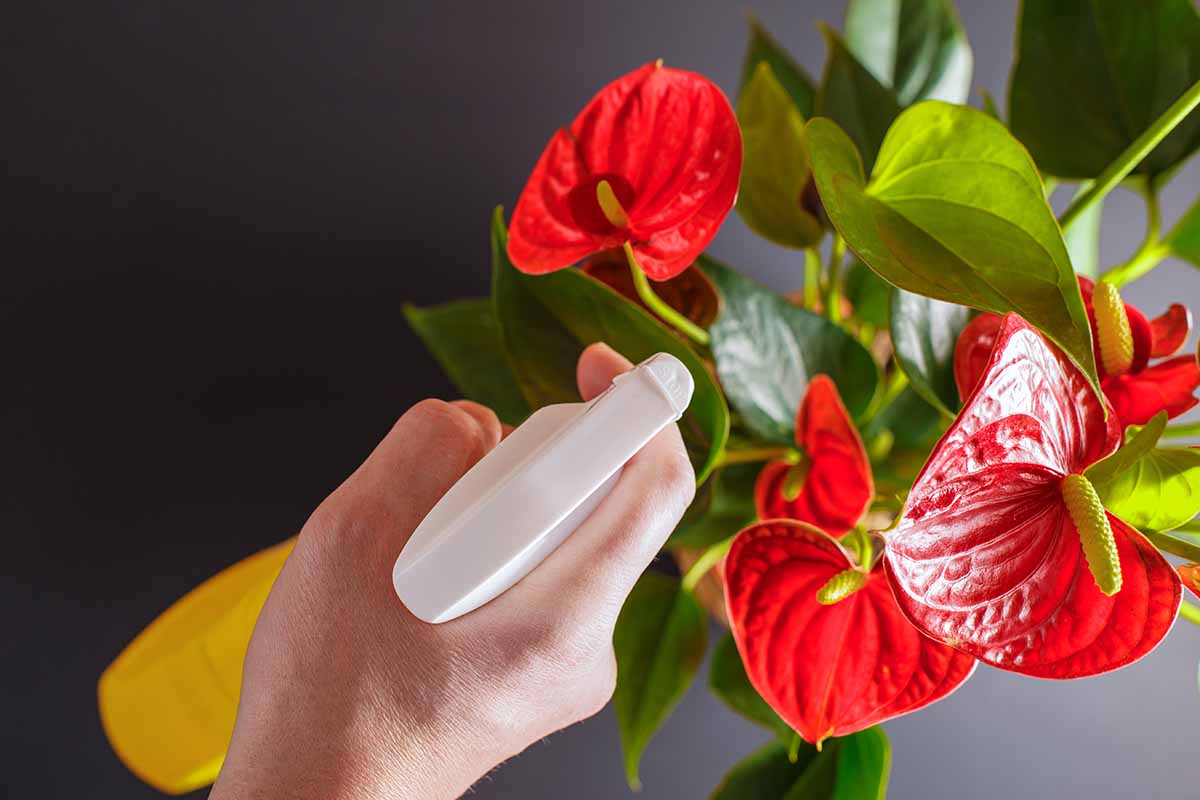
I hope you’ll have an experience like mine, where the job of determining when and how much becomes almost automatic after you’ve had the plants for a few months.
If you have tips or questions about keeping this tropical beauty hydrated, be sure to weigh in. The comments section below awaits your input!
And if you’re looking for more handy, helpful indoor gardening ideas, read these easy-care houseplant guides next:
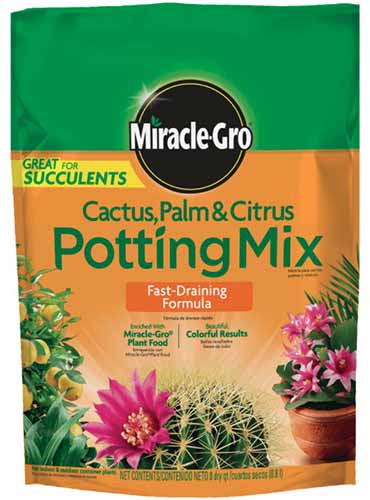
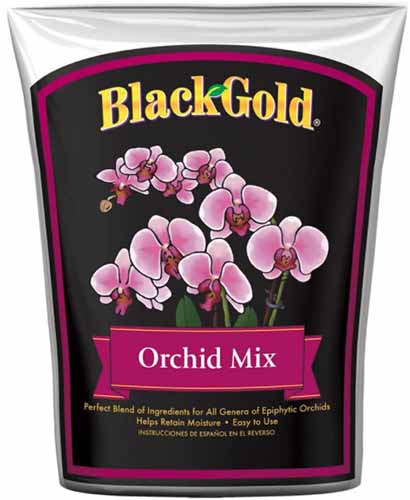
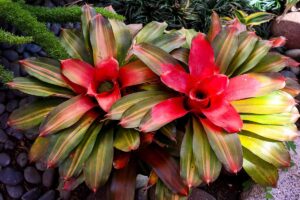

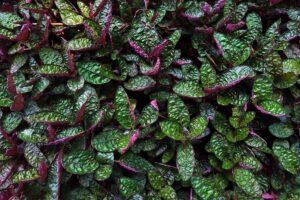
Hi Rose,
Thank you for this guide.
During the winter my plant developed brown spots on the leaves and they are spreading. Do you have some tips for this problem?
If anthurium are actually air plants and do better in an orchid type mix. Would they benefit growing in an orchid pot?
Hello CJ Roth. I would say the orchid pot offers a bit too much drainage with its holes on the sides.
.
It’s an intriguing suggestion, but I would focus more on having drainage holes at the bottom of the plant, and skip the orchid pots since they’re more expensive and fairly difficult to find.
If you do decide to give it a whirl, the Gardener’s Path staff and readership would love to see a photo.
My plant’s leaves almost all of them is having this. I got it from someone else almost dead with a flower. I put drain in that pot, didn’t work, later repotted and after 3/4 months of that, I put liquid indoor plant food (one pump with water). After that, the plant had multiple leaves (before it was 2/3) but still having these brown yellow issues on them? I water them usually once a week, water them adequately so that I can see some water is draining. After draining is comple In the sink, I put it back. It is staying… Read more »
Greetings. Great info. I’m curious tho, how does top watering (splash) cause the problem with the leaves, and yet misting does not? That boggles my brain! 🙂
Hello patricia, and thanks for the kind words.
Drops or puddles of water on the leaves can create mold. Misting should just give the plants a bit more humidity in the air, with the spray evaporating quickly.
If you have too strong of a spray, you’re correct in thinking it could leave behind droplets that don’t dry on the leaves and could encourage mold.
It’s also important to make sure the plants are spaced properly so the leaves can dry if they do get splashed.
I hope you’re enjoying your houseplants!